Should I Put a Tarp Down Under My Tent? Explained
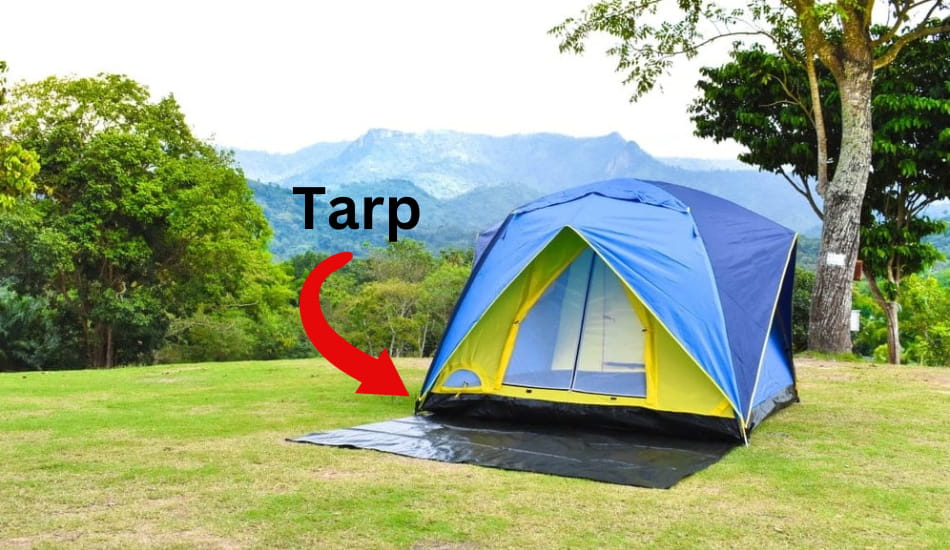
As you plan your camping adventure, you might wonder: Is placing a tarp under your tent necessary? Some camping experts will tell you they’ve never used one, while others strongly recommend it as an essential part of their setup.
Therefore, you may remain confused if you hear that from both sides. So, let’s delve into this topic and understand why putting a trap under your tent is a good thing. So, let’s start!
Should I Put a Tarp Down Under My Tent? Laying a tarp down your tent can effectively prolong its durability by shielding it from rough and uneven ground. The presence of sharp stones, twigs, or tree roots can potentially damage your tent’s base. Also, a tarp enhances insulation, reduces dampness, and simplifies the task of tidying up your tent.
Though it’s possible to camp without a tarp underneath your tent, there are many advantages you can get by using one, and at the same time, you don’t have to spend much money on it.
In this article, we’ll delve into the reasons why putting a tarp can be a good thing and what you can get with it. Keep reading to find out!
Table of Contents
What’s the Purpose Of a Tarp Under Your Tent?
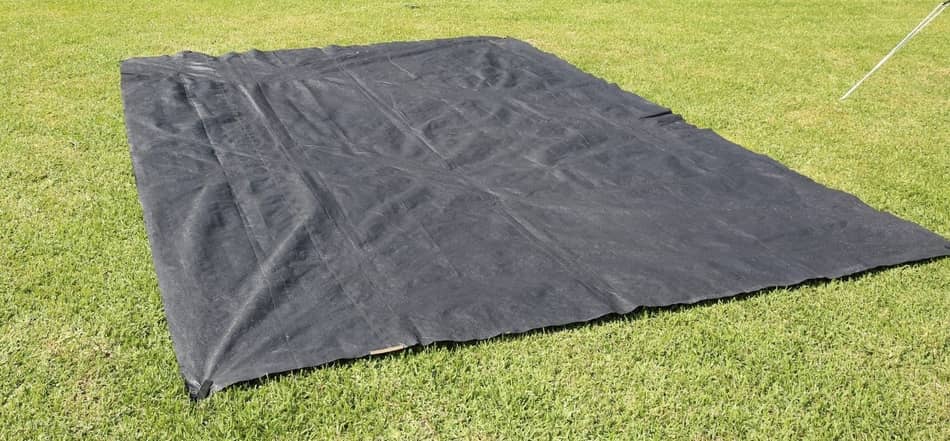
Placing a tarp under a tent comes with many advantages over drawbacks. Some tent models have integrated ground covers, but most lack this feature. A tarp serves as an affordable alternative. Here are a few reasons why putting a trap down under your tent will benefit you.
A Tarp Can Protect Your Tent’s Base
Many people aren’t aware that the main function of a ground cover, whether it’s a footprint or a tarp, is here to protect the base of your tent. High-quality tents are built to endure for many years but are often quite pricey.
Utilizing a ground cover can significantly extend your tent’s lifespan, especially if you’ve invested in a quality tent; you’d want it to serve you well for years.
Unless you exclusively set up your tent on grassy campgrounds, your tent will inevitably encounter harsh terrains replete that have sharp rocks, pebbles, and tree roots capable of damaging your tent’s bottom. Replacing a tarp is much less expensive than getting a new tent. Because of that, it’s worth placing a tarp underneath a tent.
Wild Camping Becomes More Pleasant with a Tarp
For backpackers or those who enjoy the thrill of wild camping, any additional layer is appreciated when you’re sleeping on the ground!
Therefore, having a tarp underneath your tent makes the rocky surfaces and intrusive roots much more tolerable. Furthermore, a tarp can shield your mat from any potential punctures, preventing it from deflating if you use an inflatable mat.
A Tarp Keeps A Tent Clean
Cleaning a tent can be a very boring and time-consuming task, even more so when you’re dealing with adhering mud, dirt, or pine needles on the base of your tent. Although you’ll still need to clean a tent occasionally, washing a tarp is much easier. It also simplifies the process of packing up your tent.
A Tarp Serves As A Barrier For Moisture
As the night temperature drops, the ground’s cooling effect leads to dew formation. Placing a tarp underneath your tent introduces a layer between the tent and the ground, reducing the chances of moisture seeping into your tent.
That way, the tarp also protects your tent from internal condensation by reducing the temperature disparity between the ground and the tent’s surface.
Tent Will Stay Warm Inside
Usually, most tarps are designed to use waterproof material, making them excellent insulators. However, insulation isn’t a tarp’s primary purpose, it does contribute to a slight increase in your tent’s internal warmth, a feature much appreciated during winter camping!
Related Article: How Old Do You Have to Be to Rent a Campsite? Explained
What’s the Appropriate Tarp Size for My Tent?
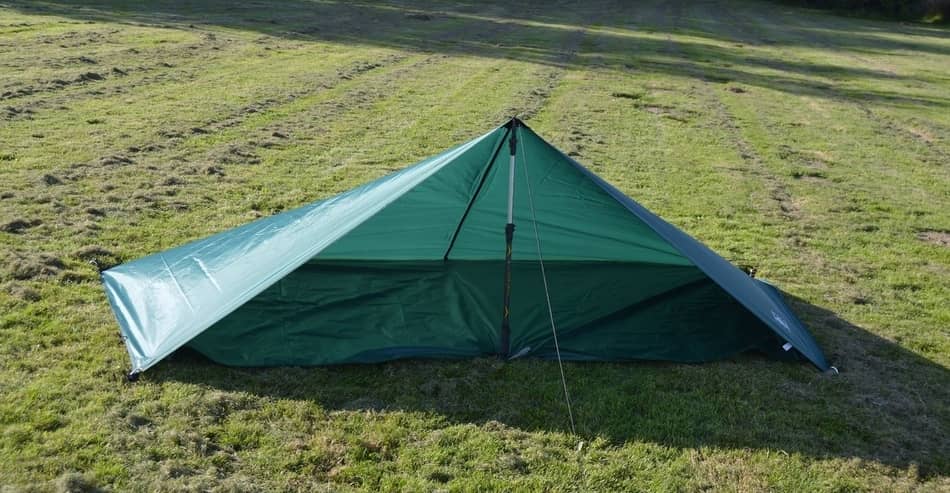
While having a tarp will provide several benefits, if it is not the correct size for your tent, it can cause more issues than it helps resolve. Therefore, it’s crucial to have the right-sized tarp.
When using a tarp beneath a tent, the tarp should match your tent’s base dimensions. A rule of thumb is that it’s too large if your tarp is visible from beneath your tent.
A lot of campers use much larger traps than they need, leading to the accumulation of water beneath their tents during the rain. A suitably sized, slightly smaller tarp can prevent this water pooling problem. In the next section, we’ll give you a table with an overview showing you the appropriate trap size for your tent.
Related Article: Do Canvas Tents Need Waterproofing?
How Big of A Tarp Do I Need
Here is a full table view of the appropriate trap size for your tent:
| Tent Size | Floor Size | Trap Size |
|---|---|---|
| 2 Pearson Tent | 7′ x 5′ | 10′ x 8′ |
| 4 Pearson Tent | 9′ x 7′ | 10′ x 10′ |
| 6 Pearson Tent | 10′ x 10′ | 14′ x 12′ |
| 8 Pearson Tent | 16′ x 7′ | 20′ x 14′ |
Make A Low-cost DIY Tarp For Your Tent
Purchasing a tarp doesn’t typically cost much money, especially compared to a custom footprint. But why not save some money by doing it yourself? It’s surprisingly easy!
When creating a tarp, search for a sturdy material that’s resilient, difficult to pierce, and either waterproof or water-repellent. Tyvek is a highly recommended material for DIY tarps due to its lightweight, breathability, durability, and waterproof properties.
Another option is plastic sheeting, often used as a painter’s drop cloth, which is waterproof, resistant to tears, and impressively durable. Remember that tarpaulin is a more robust and bulkier choice, better suited to camping compared to backpacking.
To create a DIY tarp, you’ll need the following:
- Tarp fabric. Tyvek is our top recommendation.
- Your tent
- A marker
- Anchor tabs
- Scissors
- Measuring tape
- Weights
1. Get The Right Dimensions For Your Trap
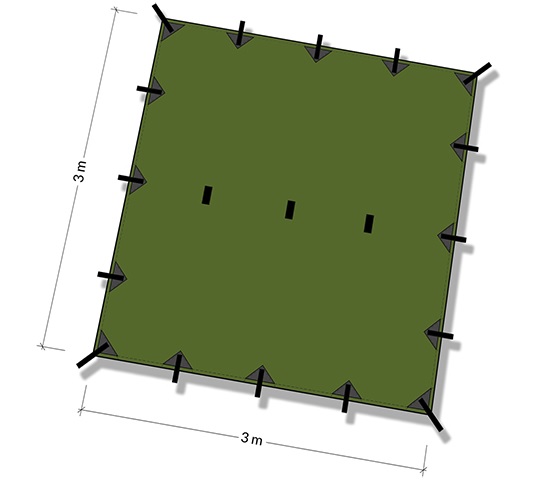
If you do not know the dimensions of a tent floor, you’ll need to measure it. You don’t need the exact right dimensions in the inch, just rough measurements. Just simply taking note of your tent’s longest and widest points will be enough.
Consider including tents with vestibules in your measurements if you want to add a small porch area – this is optional. To play it safe, opt for a tarp that’s slightly larger than the measurements you have taken.
2. Place the Tarp on a Flat Surface
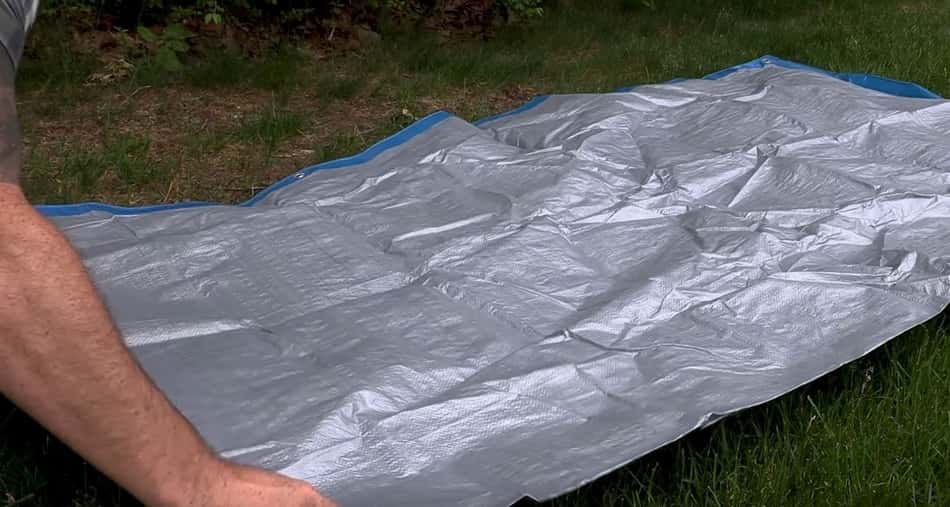
Determining your tarp’s size is much easier on a flat surface. When you have a flat surface, you can do it much faster. An even patch of your yard will do the job nicely, but an indoor area like your living room can serve the purpose if outdoor flat space isn’t available.
You could place a heavy object, such as a hammer, to eliminate any creases over the folds and press them out. If needed, anchor the corners with some weights.
3. Place A Tent On Your Tarp
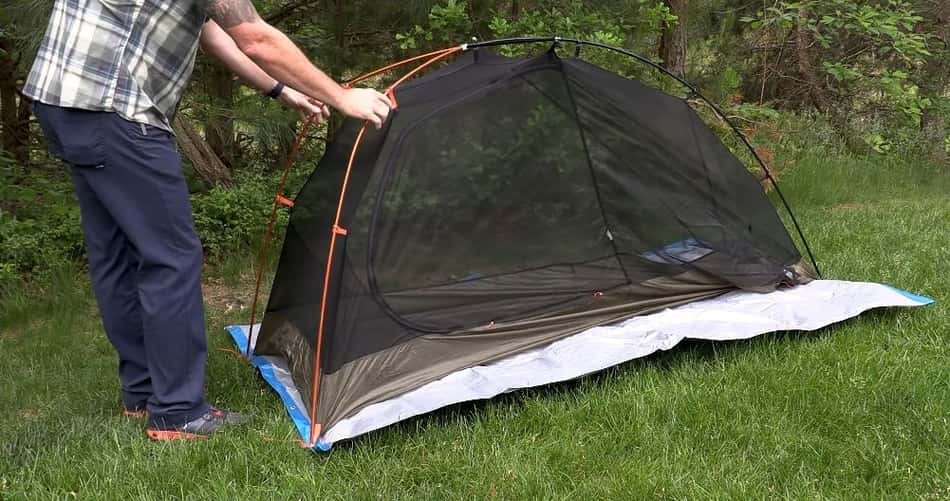
Set up your tent directly over the spread tarp. Be sure to place the rain cover after finishing this step. If you’re working outside, the tent can be held in place using stakes for more accurate tracing. If you’re inside, weights can be placed along the tent’s inner edges to hold it steady.
4. Outline The Tent Floor
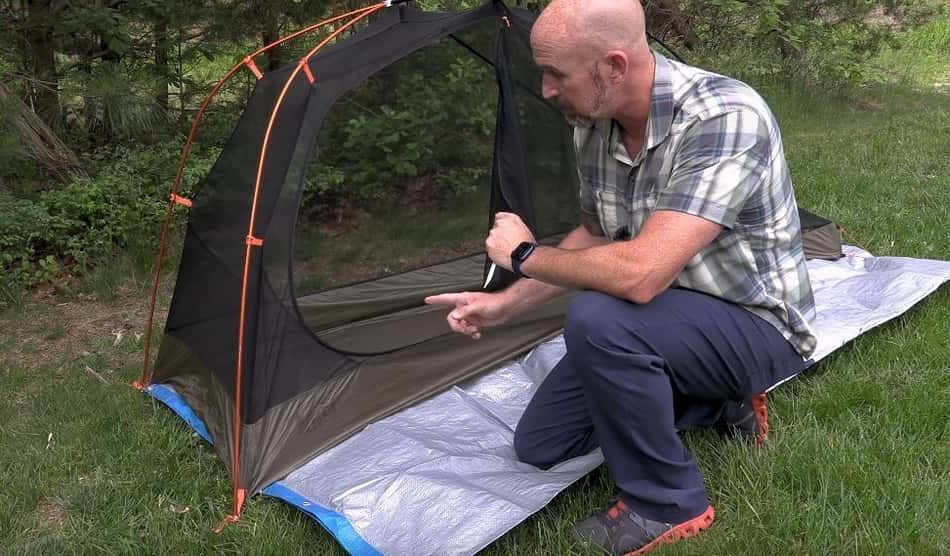
Since your tarp must be either the same size or smaller than the tent floor, the easiest way to get accurate dimensions is to trace the shape. Use some tool like a marker to outline the tent floor on the tarp, making sure not to mark the tent itself.
Here’s where those weights can be very useful! This tracing technique is especially handy for tents with unusual shapes or rounded edges.
5. Cut the Tarp According to the Traced Outline
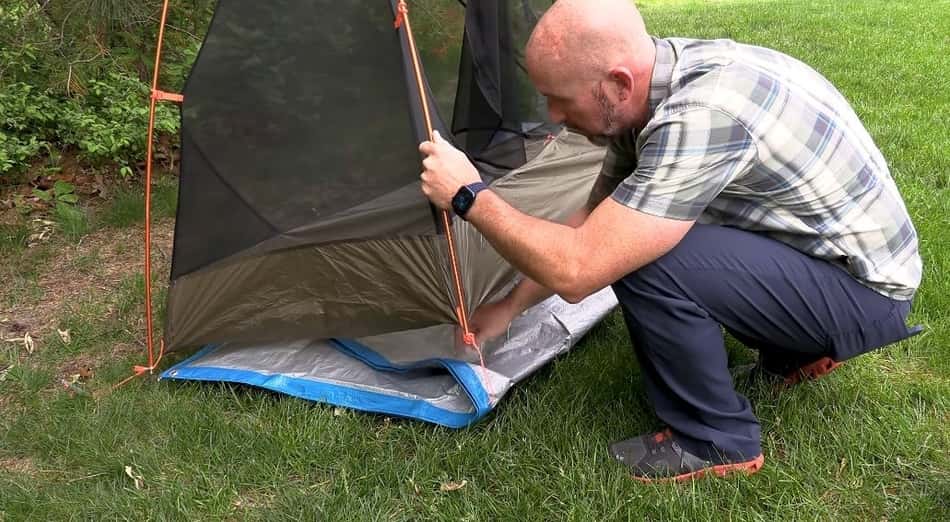
After tracing the tent outline, you can proceed to cut your tarp. If you use materials like Polycryo and Tyvek, don’t hurt yourself. While you can cut directly along the markings, reducing the size by two inches ensures no tarp edges peek out from beneath the tent.
6. Attach Anchor Tabs to Your Tarp
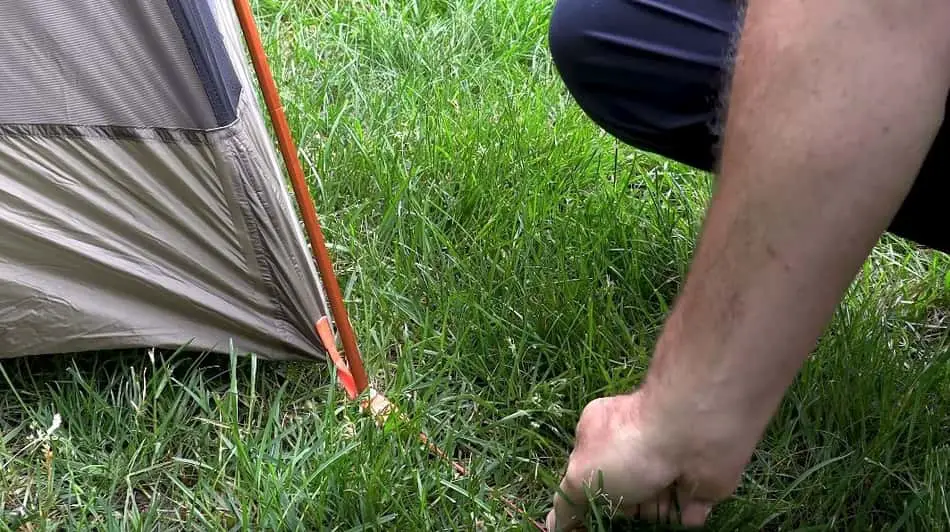
While anchor tabs aren’t technically necessary, they help anchor the tarp to the ground. In addition, their price is quite low, and there is no reason why you should not use them. Anchor tabs substitute for grommets found in retail tarps.
Most ground covers and traps have grommets for easy anchoring. When setting up camp, thread a rope through these tabs and tie the rope to your tent stakes or poles. Simple as that!
Here is also a video that shows how you can place a trap under your tent:
What Should be the Thickness of a Tarp Beneath a Tent?
The thickness of a trap is not as important as durability and resistance. For those who hike and backpack, a trap’s thickness will depend on how much weight you can or are willing to bear, the hiking distance, and the room available in your backpack. If weight is a significant factor, Polycro is a better choice.
While a thicker tarp offers protection from sharp items and rocks, it might be slightly bulky. If you’re camping with a car and have ample space for packing, opt for a thicker tarp like a hefty Tyvek. The additional size will be a worthwhile trade-off!
Where Can I Buy Custom-Sized Tarps?
Upon researching and making comparisons online, I realized that customized tarps are much more expensive than I initially thought. Their prices typically range from $30 to $80, depending on the size. You could check out coversandall.com for more details, although searching for options locally could be more better.
To my surprise, I found a lot of tarps at my nearby Harbor Freight store. Their website lists around 70 tarps of varying sizes, so you might be in for a pleasant surprise too.
Occasionally, you can find a tent footprint, a tailor-made model designed for your tent, at a very affordable price. It could be worth checking also on Amazon to see their models.
Related Article: How to Keep Bears Away While Camping? 8 Tips
Final Thoughts
The task of setting a tarp beneath your tent is very easy, yet many campers, particularly beginners, may struggle with the proper way to do it. This can cause issues, notably during wet weather.
Before placing a tarp and tent, select a flat camping area and remove any noticeable rocks, twigs, or other potential hazards that could damage your tent. Even though you’re using a tarp, eliminating clear obstacles will provide a softer resting place and is considered best practice.
Your tarp should either match or be smaller than the size of your tent’s floor. On the other hand, if you have a larger tarp available, don’t worry; it can still function as a footprint. You’ll just need to tuck the tarp’s edges underneath the tent.
This is where many tend to make mistakes; ensure that the excess tarp is folded underneath the tent and the remaining tarp, not between your tarp and the tent’s floor. Following this folding technique, you will prevent the water from gathering underneath the tent.
